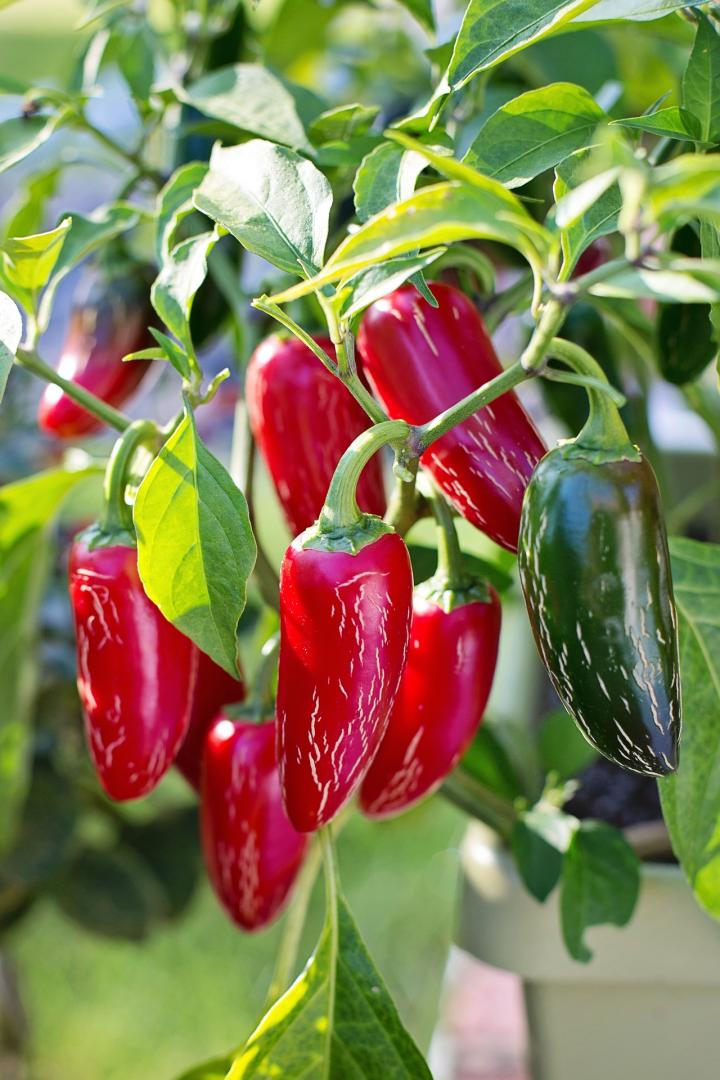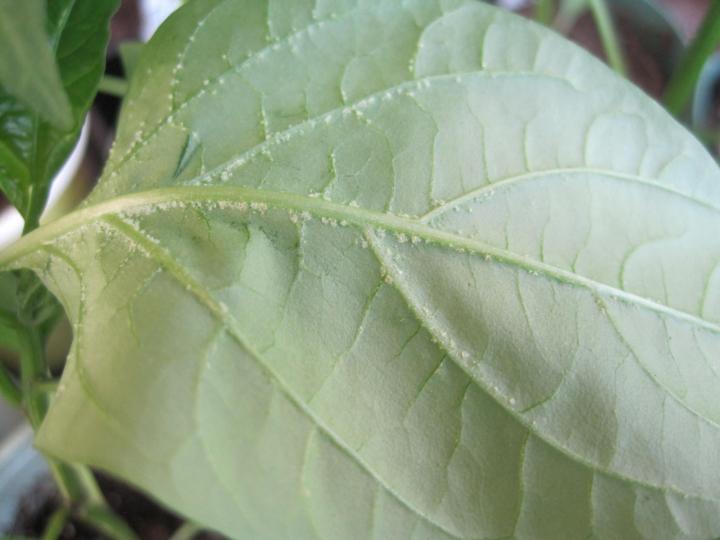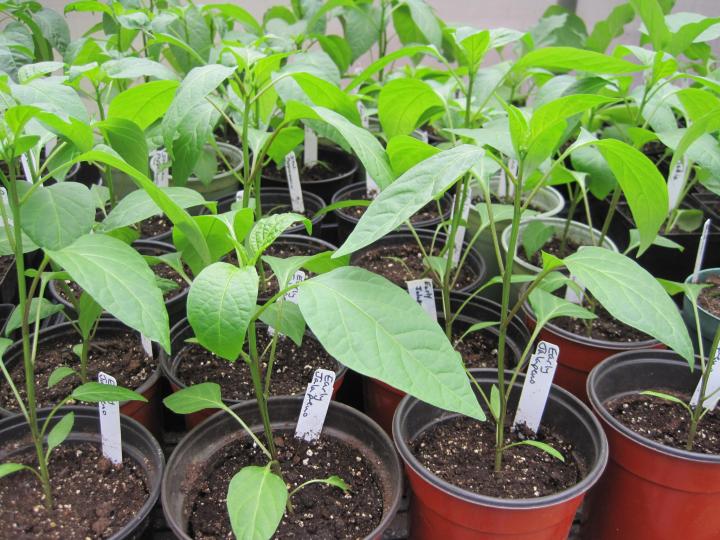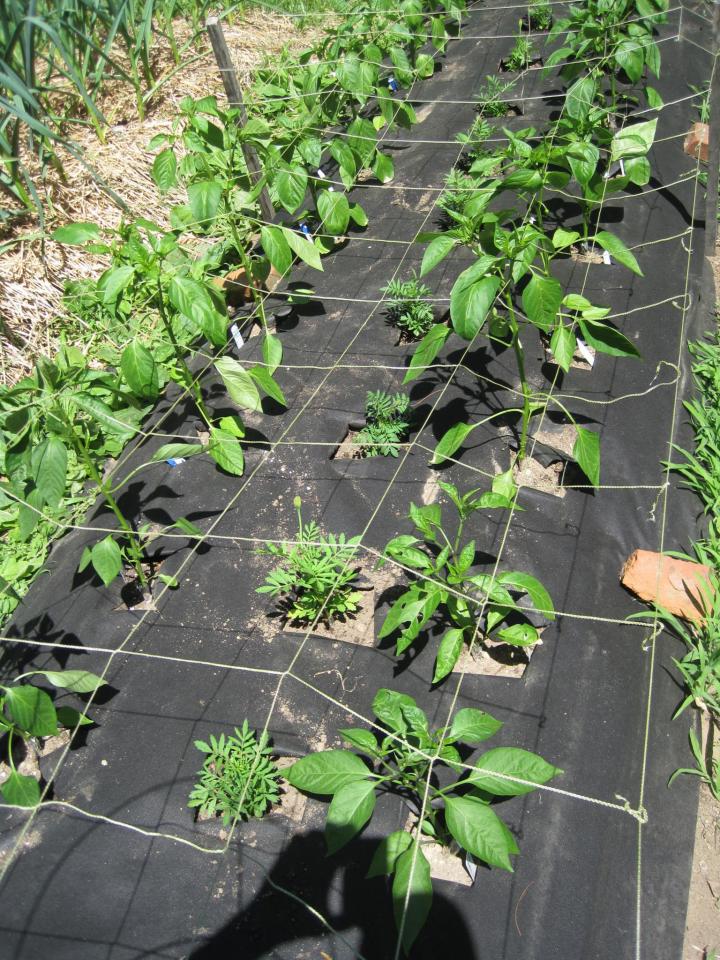Peppers rarely have serious issues in the vegetable garden. However, this year, we had some pepper growing problems. I thought I’d share our experiences so that you may also benefit if your peppers have problems!
We have grown 10 to 20 different types of hot peppers every spring for many years with no problem whatsoever. Our plant customers appreciate the variety ranging from mildly hot ‘Anaheim’ to super hot ‘Moruga Scorpion’ and then there are the “Russian roulette” ones like ‘Shishito’ and ‘Padron’ that like to surprise you with one in ten being hot while the rest are not.

Jalapenos are my favorite. Not too hot and they pickle well.
Burning Questions
This year, I noticed some leaf curling on a few of the pepper plants—only the hot ones. Naturally I assumed it meant they needed more water. The next day they were worse and more plants were affected. It was time to take a closer look.

Why Are the Leaves on My Peppers Curling?
On the underside of the leaves were little white fuzzy blobs along the veins. They were easily squished, which led me to think it must be some sort of tiny insect. To get a proper ID of what critter this might be (spider mite? thrip? mealybug?), we sent a picture to our cooperative extension entomologist. Since I thought that it could take days to get an answer, I charged ahead and sprayed the affected plants with a mixture of dish soap and alcohol diluted with water.
To my surprise, we got an answer right away! They were not insects at all but water crystals. The plants had edema, also called water blistering, from too much water. They advised us to let the plants dry out to the point of starting to wilt before watering again. Warm wet soil and high humidity cause the roots to absorb water faster than the leaves can either use it or expel it through transpiration so the plant pushes it out through cell walls.

Since space in our greenhouse is at a premium this time of year, the plants were packed tightly together and air circulation, even though we have a fan blowing on them, just wasn’t adequate to dispel the humidity. Since the leaves with edema are already damaged, we had to keep an eye on new leaves to see if they would be affected as well but so far only the ‘Inferno Hot Banana’ plants seem to be still suffering. Another lesson learned the hard way!
Growing Hot Peppers
Hot peppers are tropical natives so don’t plant yours outside until all danger of frost has passed and the night temperatures are above 60 degrees. In cold areas of the country, you can use black plastic mulch to heat up the soil. In warmer areas, you can remove the plastic before planting and switch to an organic mulch such as shredded leaves, straw, or grass clippings to keep the soil moist and cool during blistering hot weather.
Plant them in your sunniest location or grow them in containers placed in full sun. Grow a few in containers so you can bring them in at the end of the season and continue the pepper party into winter.
Supporting Peppers
Tall plants or those that bear heavily will need some support.

We place netting horizontally across the whole bed and grow the plants up through the mesh. If you have only a few plants, tomato cages work well. Cover your new transplants with reemay to protect them and hold in a little bit of extra heat. Once the plants begin to flower, remove the covering so the blossoms can be pollinated.
Why Do Peppers Drop Blossoms?
Hot peppers like heat more than bell peppers do but when it gets to be over 90 to 100 degrees F, they can drop their blossoms. Hot peppers grow best when days are between 65 and 85 degrees and nights are 60 to 70 degrees.
If extremely hot sun, peppers can also get sunscald. The fruit won’t fully develop or may get tannish spots. This is similar to sunburn on humans! It’s best to protect the fruit with a sun shade or move the peppers if they are in containers.
Why Aren’t My Peppers Fruiting?
Fruit doesn’t set when the temperatures are below 55 degrees or over 95. Flowers can also drop when nights are over 75 degrees. When the plants start to blossom you can side-dress them with compost or well-rotted manure or give them a drink of fish fertilizer. Don’t feed them with a high nitrogen fertilizer or you will grow a lush and leafy plant with little or no fruit.
Don’t overwater like I did! Let the top inch or two of soil dry out before watering. Many people claim that depriving the plants of water makes the fruits even hotter but uneven watering can cause problems such as blossom end rot.
Why Do My Peppers Have Black Spots?
Blossom end rot (BER) shows up as dark, sunken spots at the end of your peppers. The most common cause is a calcium deficiency due to uneven watering or too much nitrogen. You can eat peppers with BER—just cut the bottoms off. For a quick fix, treat plants with a calcium spray for BER. Keep soil consistently moist; using mulch helps. Test soil when pepper season ends. Amend as needed.
When to Pick Hot Peppers
Mature peppers are the hottest so resist the urge to pick them before they are ripe. The oil that gives hot peppers their kick is called capsaicin. It is most concentrated in the white membranes and seeds inside the fruit. Be cautious when handling hot peppers; wear gloves and don’t touch your eyes!
Tricks I Have Not Tried
Many people swear by placing match heads in the planting hole to add sulfur. Some believe that stressed plants produce the hottest peppers. A gardener in England stresses his plants by yelling at them, depriving them of water, and ripping pieces off the leaves to scare them. Maybe there is something to his extreme efforts. He holds the record for the hottest peppers in the UK!
To learn more about growing peppers and pepper problems, visit the Almanac’s Pepper Growing Guide.
There is also a helpful “how to” video that demonstrates how to grow peppers here.


Comments